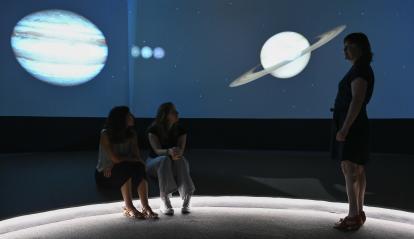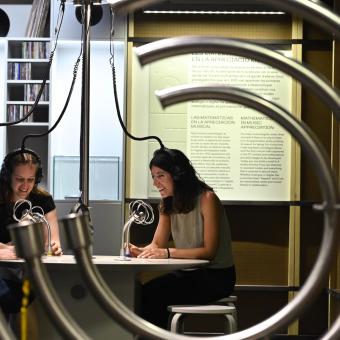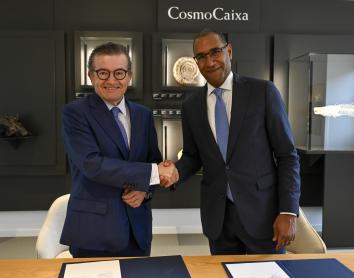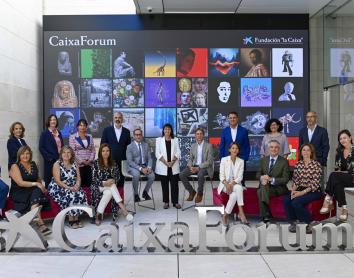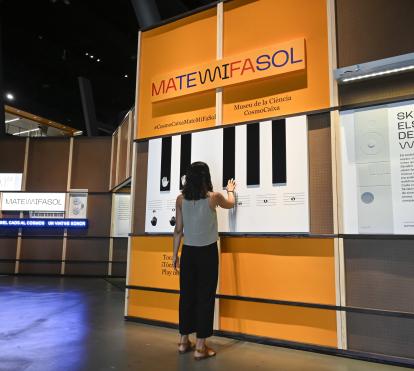
Seven areas, seven notes of the pentagram at CosmoCaixa
10.07.24
11 minutes readAfter having the opportunity to create their own melody on a giant keyboard located at the entrance to the exhibition, the public of MateMiFaSol will be able to find out what the numbers that give each area its name mean in relation to sound and music: 0, 0.00002, 1, 440, 1607, 100,000 and ∞ (infinity).
0 In the beginning was silence
Before chaos there was silence. The exhibition begins in a space resembling an anechoic (echo-free) chamber, lined with carpeting and other materials that reduce the intensity of external sound. Visitors can watch on a monitor a performance by the pianist Joana Gama of the work 4 minutes 33 seconds, by the experimental musician John Cage. The piece has no notes at all. Each time it is performed it changes because of incidental or random sounds. What may seem like a joke is a reflection on silence as the absence of all sound, but sound nonetheless.
With the birth of the universe came the breaking of the silence. In 1948, physicist George Gamow, along with some collaborators, created the mathematical developments that shaped the Big Bang theory. The name sounds like a comic book onomatopoeia, but experts assert that the sound of that original moment would not have resembled an explosion. Based on his research, physicist John Cramer has produced a recreation of the sound that must have been heard at that initiatory moment, and it can be heard on a loop in the exhibition.
After the Big Bang, the cosmos began to function like a sound machine. We hear the sounds of chaos: turbulence, infrasonic vibrations; geology: earthquakes and volcanoes; the atmosphere: oceans and winds. We hear animals and, finally, human beings with their songs, music and dances.
An interactive module allows visitors to create and listen to their own soundscapes by combining different clips from a sound library.
0.00002 Much less than a whisper
The minimum volume of sound that humans are able to hear when there is no noise pollution is 0.00002 pascals. An allegorical installation allows visitors to become aware of this tiny measure: the sound produced by a grain of sand falling into a dinner plate.
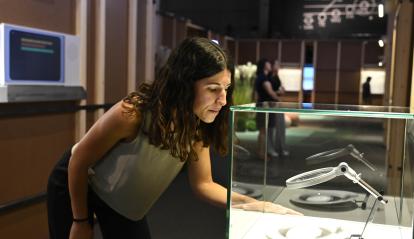
The cochlea is a structure in the inner ear that “translates” acoustic information into nerve impulses for the human brain to understand. Inside the cochlea are cilia that only detect certain frequencies. An audiovisual film describes the physiological process of hearing.
In addition, this area explores noise and tone, which are the two sides of sound. Noise lacks regularity and periodicity, is chaotic and causes a sensation that is unpleasant or annoying to our brain. In contrast, tone has regular, periodic and measurable patterns that often produce a pleasant sensation.
An interactive module enables visitors to add different frequencies to create white noise or pink noise. What is white noise? Just as white light contains all the frequencies of the visible spectrum, white noise contains all the sequences of sound. It is the sound we hear when we try to tune an analogue television. Pink noise is characterised by a spectral density inversely proportional to frequency. It is a sound with less treble or high frequencies.
1 Measuring beauty and emotion
We are in the 6th century BC. The philosopher Pythagoras is walking down the street. He passes a blacksmith, hears the hammer striking the anvil and realises that each time it sounds different. The idea occurs to him that the different tones have something to do with matter and, to prove his hypothesis, he creates an instrument with only one string, the monochord, with which he begins to experiment. If you have a string of length L and you divide it in half, the sound is the same, but with an octave difference. From there he makes a series of subdivisions that give rise to the seven notes of the natural scale.
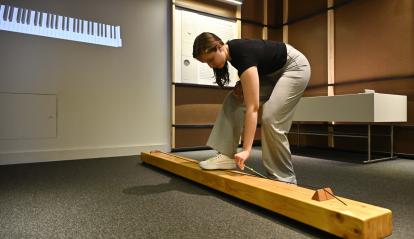
In this area, visitors can see a replica of Marin Mersenne’s monochord (17th century) and re-enact Pythagoras’ experiment with an interactive virtual monochord. They can also walk on a giant monochord to produce notes.
An audiovisual presentation explains the origin of different stringed instruments in Classical Greece, culminating in the lyre, a complex instrument that makes it possible to play chords: sets of two or more notes that, when played simultaneously, form a harmonic unit.
This section also delves into why we like music. It is essentially an aesthetic experience that has a mathematical basis. The golden ratio, much studied in nature and architecture, also exists in music. In the 16th century, the mathematician Leonardo of Pisa, known as Fibonacci, established an infinite numerical sequence that is at the basis of ideal beauty. Interestingly, the distribution of the notes on a piano follows the Fibonacci sequence: 1, 2, 3, 5. Eight white keys and five black keys in an octave.
The golden ratio appears where you least expect it. Most pop songs, for example, have the climax when 61.8% of the time has elapsed. Often this is not premeditated, but the composer’s intuition leads him or her to that point spontaneously, because it creates a more proportionate, more harmonious and more aesthetic effect, in short, more pleasing to the listener.
440 Look at the sound, listen to the number
The title of this room refers to the frequency of 440 Hz at 20ºC, which is the standard for tuning stringed instruments.
In this area we will learn about timbre, which is the result of introducing harmonics, multiples of the fundamental frequency. Mathematics plays a decisive role here. It introduces variables such as hertz (the number of times a string vibrates per second) or decibels (a logarithmic scale for measuring the intensity of a sound).
We will also discover the Fourier series. When a string vibrates, there is a fundamental frequency at which it vibrates – an E, for example – and other frequencies which are multiples of the fundamental and which resonate. If we add up all these frequencies sounding at the same time at a given volume, we get a timbre: the E of a guitar sounds different from the E of a trumpet or the E of the human voice.
An audiovisual presentation explains that the timbre of instruments is constructed in the same way as a cooking recipe. We will also learn how synthesizers can reproduce the timbre of any instrument in such a way that it is indistinguishable from the original, although specialists tell us that the wood and varnish give nuances that no machine can achieve.
Three multimedia interactives allow us to create different types of waves, play with frequencies and amplitudes and understand the concept of resonance. We can also discover Chladni figures, which are the geometric patterns formed by placing a granular substance such as sand or sawdust on a flat surface that vibrates at different frequencies. By experiencing this first hand through the interactive and watching an impressive video by the New Zealand artist Nigel Stanford, we will discover that this phenomenon is related to standing waves, in other words, those oscillations in which certain points (nodes) do not move.
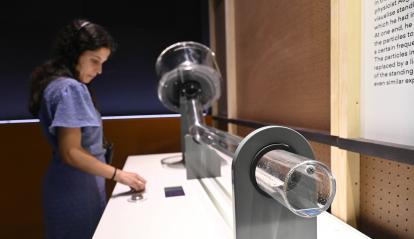
Many of the contributions of mathematics to music have their own names. A retrospective section presents various cultural figures who have combined the two disciplines, from Pythagoras to the electroacoustic composer Elizabeth Hinkle-Turner, and including Copernicus, Johannes Kepler, Lewis Carroll and Albert Einstein.
1607 The music of matter
1607 is a key year in the history of music: the composer Claudio Monteverdi premiered what is considered the first opera, The Fable of Orpheus. Musical creation, performance and appreciation came together in a way never seen before and changed our perception of music, which from that moment on was made to be shared. When we talk about music, what point of view do we adopt? That of the creator? Of the performer? Of the audience listening to it at a concert or on an MP3 player? For many musicologists, music does not exist without someone listening to it.
With the advent of concert halls, mathematical acoustics was born. Today we can have a Hi-Fi studio at home with a sound absorption system. And thanks to mathematics we can manipulate, store and send music. We can say that Monteverdi’s Orpheus was the Big Bang of music.
This section also explores the role of mathematics in musical creation. Composition, performance, rhythm and melody can follow very rigid or completely random laws. Different organisations of notes, patterns and time signatures are created, leading to very complex structures such as medieval polyphony or electroacoustic music. From Bach through Mozart to Xenakis, we find music that is truly geometric.
The arithmetic of rhythm, geometry of melody and logic of harmony are three key concepts that are also presented in this, the largest area of the exhibition.
A large sculptural instrument – the Omele Machine – allows the creation of binary, ternary or quaternary rhythms. Visitors can also create their own compositions with the composing machine, which works like a barrel organ and looks like a bicycle. In addition, a multimedia interactive invites us to generate the most basic rhythms (2/4, 3/4) and play with them to understand the rhythmic foundation of almost all contemporary music.
With various interactive modules, we create melodies and transform our voice (robotic voice, very high or very low voice), and from very simple melodies we introduce linear transformations: repetition, mirror effect, retrogradation...

Thanks to another multimedia interactive, we can see the role of chance in musical composition. This is Mozart’s dice game, which allows us to combine existing bars and generate an almost infinite number of melodies that always sound good. Visitors to the exhibition can generate a random melody and capture it via a QR code to listen to it on their mobile phone or share it on social networks.
100.000 The music of life
The title of this section tells us that life is full of sounds that have mathematics behind them. 100,000 is the approximate number of times the human heart beats in a day.
Our body functions like a polyphony: heart, lungs, digestive system mark the different personal sounds. An interactive multimedia allows us to simulate a scan of our body and discover the various rhythms produced simultaneously inside us. This is what is known scientifically as chronobiology.
This area also explores bioacoustics (the science that studies the sounds of nature) and zoomusicology (the science that studies the music of non-human animals). A loop of animal sounds combined with an audiovisual presentation explains the multiple uses they give to their “musical compositions” and also brings us closer to great composers who have been inspired by nature to create their works
Similarly, the influence of music on the body and on people’s state of mind is also an area of study that is receiving increasing attention. Notes and chords, as well as the mathematical proportions they hide, can have a positive effect on people’s well-being because music activates the brain on a sensory, perceptual-cognitive and emotional level, as we can see in an audiovisual. Increased knowledge of these effects opens the door to applications in the treatment of autism, brain injuries and neurodegenerative diseases.
∞ The music of the spheres
Since the beginnings of philosophical reflection, music has provided an explanatory model of the universe. The astronomer Johannes Kepler was passionate about polyphony, as well as a great mathematician. By combining music and mathematics, he configured a dynamic, musical model of the cosmos that has fascinated mankind. According to Kepler’s model, the planets form a choir with voices in bass, tenor, alto and soprano, and sing together an infinite harmony governed by the proportions discovered by Pythagoras.
The exhibition has a grand finale: a spectacular audiovisual presentation featuring the six planets known in Kepler’s time: Saturn and Jupiter (basses), Mars (tenor), Earth and Venus (altos), and Mercury (soprano). Visitors sit in the centre of a circular room, like the angels Kepler imagined in his writings, seated in the sun and listening to the cosmic music. The installation simulates the solar ecliptic: an imaginary line or band along which the planets move against a backdrop of fixed stars.
Kepler said that the frequency with which the planets sounded was related to their angular velocity. Planets that rotate faster make higher-pitched sounds, and those that rotate slower make lower-pitched sounds. And because the orbits are not circular, they generate an ascending and descending melody. In the exhibition, this has been reproduced with human voices that create a choir of great beauty. A powerful and evocative finale.
